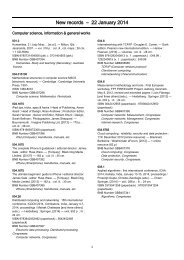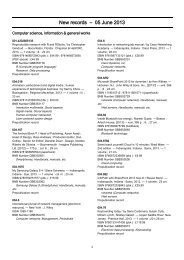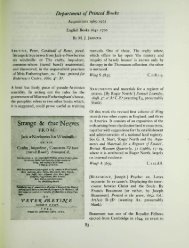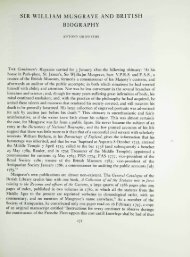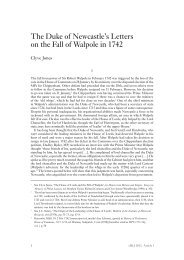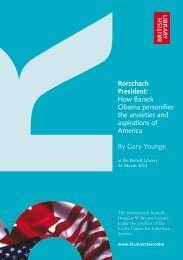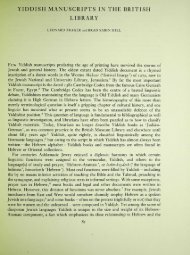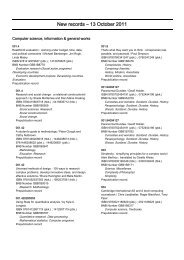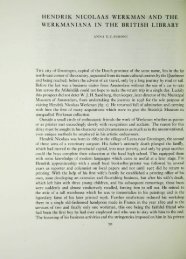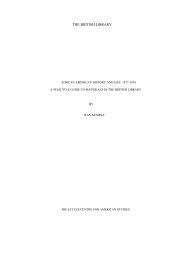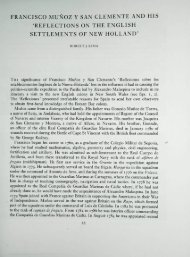A Medieval Psalter 'Perfected': Eighteenth-Century ... - British Library
A Medieval Psalter 'Perfected': Eighteenth-Century ... - British Library
A Medieval Psalter 'Perfected': Eighteenth-Century ... - British Library
You also want an ePaper? Increase the reach of your titles
YUMPU automatically turns print PDFs into web optimized ePapers that Google loves.
A <strong>Medieval</strong> <strong>Psalter</strong> ‘Perfected’: <strong>Eighteenth</strong>-<strong>Century</strong> Conservationism and an Early (Female) Restorer<br />
of Rare Books and Manuscripts<br />
cusp of what eventually became a common practice in the following century. 41<br />
An account offered by one later figure, John Harris (1791–1873), suggests that Denyer<br />
was not alone in restoring by facsimile rare books and manuscripts. Harris is well known<br />
as an artist who enjoyed a successful career as a facsimilist in the nineteenth century,<br />
restoring new paintings to damaged or incomplete manuscripts in some of England’s most<br />
renowned collections. 42 He showed his work in the Great Exhibition of 1851, for which he<br />
contributed information on his craft to the juries’ report. In this brief account, Harris credits<br />
the origins of his work to individuals who appear to have been contemporary with Denyer:<br />
In the history of mankind there are few things so remarkable as that the press<br />
and the easel have been the means of producing works of art which have most<br />
conspicuously tended to the civilization of man and the unity of nations. The<br />
avidity with which these productions are sought after up to the present time<br />
is fully proved by the prices given either for early printed books or ancient<br />
paintings of which the former especially are often imperfect. From this latter<br />
circumstance the collector has been induced to seek the means of having ancient<br />
and valuable works in typography and painting completed by fac-similes, and<br />
thus restoring to the present generation works which most probably in a few<br />
more years would have been buried in oblivion. It was about the year 1815 that<br />
I was first employed by the late Mr John Whittaker, of Westminster, an eminent<br />
bookbinder at that period; and I believe the idea of having ancient books of the<br />
early printers, &c., perfected by facsimiles was first suggested to him by the late<br />
Earl Spencer, for whom many books were so done; and numerous specimens<br />
are preserved of some of the rarest productions of the press in the library at<br />
Althorpe. Specimens are also to be seen in the King’s <strong>Library</strong>, which were done<br />
in the lifetime of His Majesty King George III., the art of imitation by facsimile<br />
being patronized by him; also by the late Earl Fitzwilliam, the Hon. Thomas<br />
Grenville and many others. 43<br />
Harris’s report encourages the thought that Denyer did indeed have peers in the restoration<br />
of rare books and manuscripts. Were she a singular practitioner of this form of conservation,<br />
she would be an intriguing anomaly and interesting forerunner, but one who offers little<br />
by way of commentary on the broader cultural trends of her time. However, both Harris’s<br />
report and parallel developments in architectural preservation show that Denyer’s activities<br />
were not carried out in isolation: it was in this period that the ideas of historic preservation,<br />
restoration and cultural heritage were born, and if we broaden our purview to include other<br />
media, Denyer’s methodologies appear far from singular. They are, in fact, of a piece with the<br />
emerging historicism of the time, and the practices of monumental restoration, ‘improvement’<br />
and ‘perfection’ that made beautiful mongrels of Durham, Hereford, Lichfield and countless<br />
other ecclesiastical structures. 44 To many – but not all – pioneers of conservationism, the<br />
greatest tribute to the past was to leave a piece of one’s self in it.<br />
42<br />
On John Harris, see Janet Ing Freeman, ‘Harris, John (1791–1873)’, Oxford Dictionary of National Biography<br />
(Oxford University Press, 2004) [http://www.oxforddnb.com/view/article/37514, accessed 25 May 2012];<br />
and Barry Gaines, ‘A Forgotten Artist: John Harris and the Rylands Copy of Caxton’s Edition of Malory’,<br />
Bulletin of the John Rylands University <strong>Library</strong>, lii (1969–70), pp. 115–28. See, also, for a similar manuscript<br />
restorer of the nineteenth century, Janet Backhouse, ‘A Victorian Connoisseur and His Manuscripts: The Tale<br />
of Mr. Jarman and Mr. Wing’, The <strong>British</strong> Museum Quarterly, xxxii (1968), pp. 76-87.<br />
43<br />
Reports by the Juries: Exhibition of the Works of Industry of All Nations, 1851. On the Subjects in the Thirty<br />
Classes into which the Exhibition was Divided (London, 1852), p. 405.<br />
44<br />
See Rosemary Sweet, Antiquaries:The Discovery of the Past in <strong>Eighteenth</strong>-<strong>Century</strong> Britain (London, 2004), esp.<br />
pp. 277-307.<br />
26<br />
eBLJ 2013, Article 3



